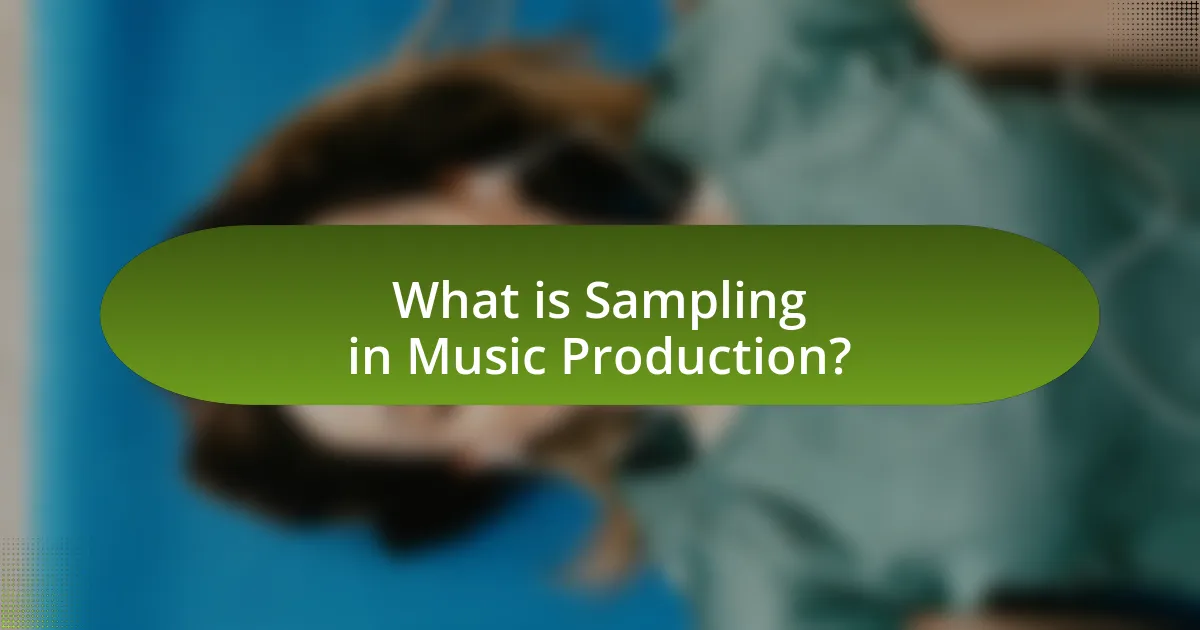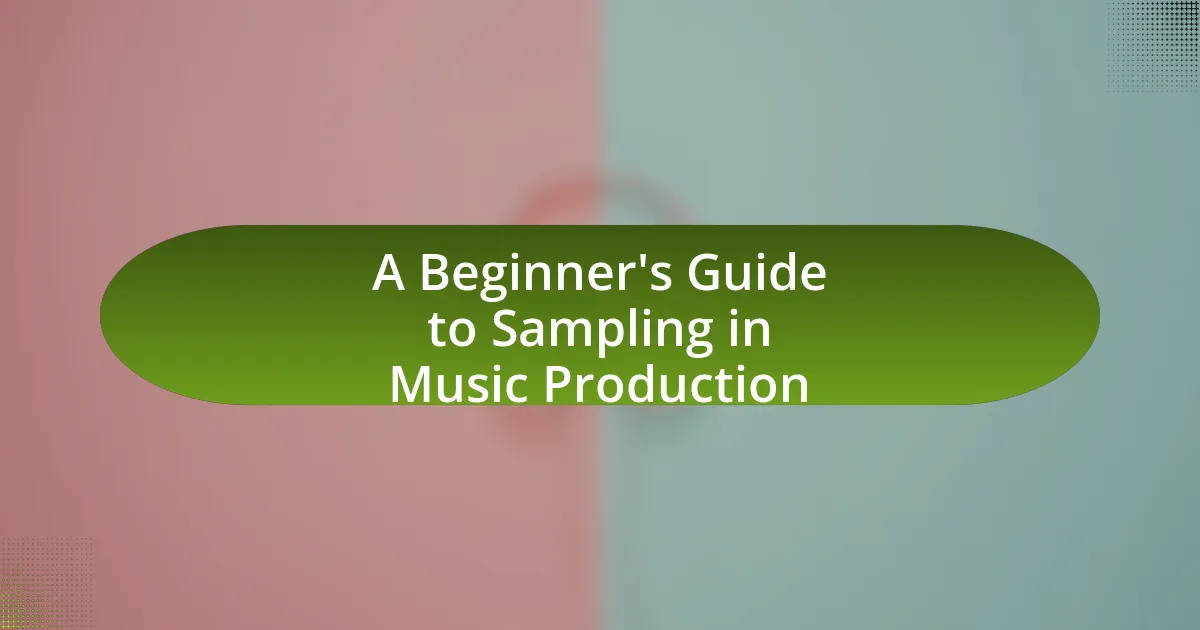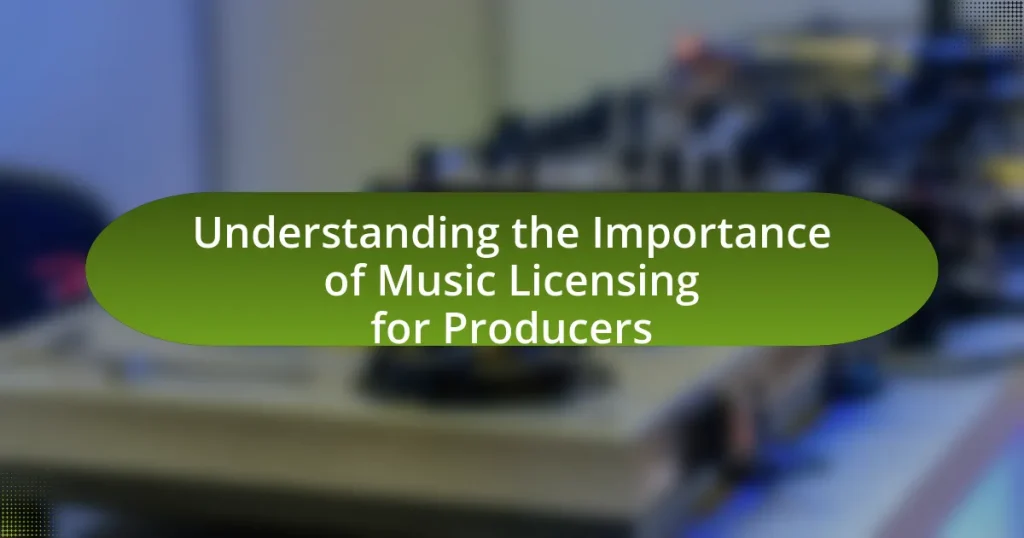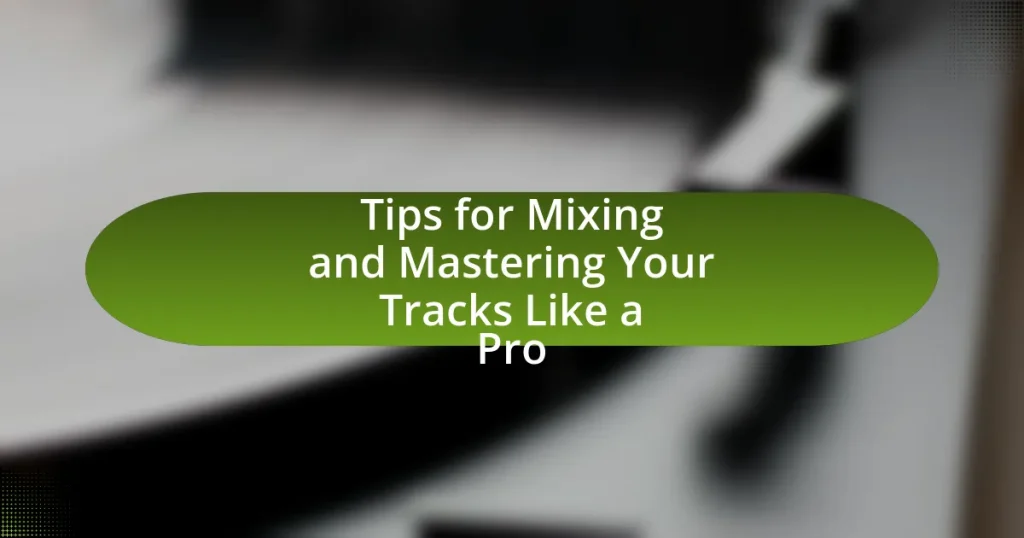Sampling in music production refers to the technique of taking portions of existing sound recordings and reusing them in new compositions, a practice that has roots in hip-hop and electronic music. The article explores the origins of sampling, its historical significance, and the technological advancements that have shaped its evolution. It discusses various types of sampling, including loop and one-shot sampling, and highlights the importance of legal considerations and best practices in the sampling process. Additionally, the article provides guidance for beginners on tools, techniques, and common pitfalls to avoid, emphasizing the role of sampling in enhancing creativity across different music genres.

What is Sampling in Music Production?
Sampling in music production is the process of taking a portion of a sound recording and reusing it in a different song or piece of music. This technique allows producers to incorporate existing audio elements, such as melodies, rhythms, or vocal snippets, into new compositions, thereby creating a unique blend of sounds. The practice of sampling has historical roots in hip-hop and electronic music, where artists like Grandmaster Flash and Afrika Bambaataa popularized its use in the late 1970s and early 1980s. Sampling is often facilitated by digital audio workstations (DAWs) and samplers, which enable precise manipulation of audio clips, including pitch shifting, time stretching, and looping.
How did sampling originate in music production?
Sampling originated in music production during the 1960s and 1970s with the advent of tape machines and electronic instruments. Early pioneers like Brian Eno and the use of the Mellotron allowed musicians to manipulate recorded sounds, leading to the incorporation of snippets from existing recordings into new compositions. This practice gained momentum in hip-hop during the late 1970s and 1980s, where artists like DJ Kool Herc and Grandmaster Flash utilized turntables to loop and layer samples from funk and soul records, creating a new genre. The legal and technological developments surrounding sampling, including the introduction of digital samplers in the 1980s, further solidified its role in music production, allowing for more complex and varied sound manipulation.
What historical events contributed to the rise of sampling?
The rise of sampling in music production was significantly influenced by the advent of hip-hop culture in the late 1970s and early 1980s, which popularized the technique of reusing existing recordings. The introduction of affordable digital samplers, such as the Akai MPC series in the mid-1980s, further facilitated this trend by allowing producers to easily manipulate and integrate samples into their compositions. Additionally, the legal battles over copyright and sampling, notably the 1991 case involving Biz Markie’s “Alone Again,” highlighted the complexities of sampling and ultimately shaped the industry’s approach to the practice. These events collectively contributed to the widespread acceptance and evolution of sampling as a fundamental element in music production.
How has technology influenced the evolution of sampling?
Technology has significantly influenced the evolution of sampling by enabling more sophisticated and accessible tools for music production. The introduction of digital audio workstations (DAWs) in the 1990s allowed producers to manipulate samples with precision, facilitating complex arrangements and effects that were previously difficult to achieve. Additionally, advancements in hardware, such as samplers and synthesizers, have expanded the range of sounds available for sampling, allowing for greater creativity and innovation in music genres. The rise of the internet has also democratized access to samples, with platforms offering vast libraries of sounds that artists can easily incorporate into their work. These technological developments have transformed sampling from a niche practice into a fundamental aspect of modern music production.
What are the different types of sampling?
The different types of sampling in music production include loop sampling, one-shot sampling, and granular sampling. Loop sampling involves repeating a short segment of audio to create a rhythmic or melodic pattern, commonly used in genres like hip-hop and electronic music. One-shot sampling refers to capturing a single sound or note, which can be triggered at various pitches and velocities, often utilized in drum machines and samplers. Granular sampling breaks audio into small grains, allowing for manipulation of pitch, time, and texture, enabling innovative sound design. Each type serves distinct creative purposes in music production, enhancing the overall sonic palette.
What is the difference between audio sampling and MIDI sampling?
Audio sampling involves capturing and manipulating actual sound recordings, while MIDI sampling uses digital signals to represent musical notes and performance data. In audio sampling, sound waves are recorded from instruments or vocals, allowing for the playback of real audio clips. In contrast, MIDI sampling does not involve actual audio; instead, it sends information about pitch, duration, and velocity to trigger virtual instruments or synthesizers. This distinction is crucial in music production, as audio sampling provides realistic sound textures, whereas MIDI sampling offers flexibility in composition and arrangement.
How do loop-based samples differ from one-shot samples?
Loop-based samples consist of repeating audio segments designed to create a continuous sound, while one-shot samples are individual audio clips meant to be triggered once. Loop-based samples are often used to establish rhythmic or melodic foundations in a track, allowing for seamless integration and layering, whereas one-shot samples are typically utilized for specific sounds or effects, such as drum hits or vocal snippets, providing distinct moments in a composition. This distinction is crucial in music production, as loop-based samples facilitate ongoing musical ideas, while one-shot samples contribute to dynamic variation and texture within a piece.
Why is sampling important in music production?
Sampling is important in music production because it allows producers to incorporate pre-existing sounds and musical elements into new compositions, enhancing creativity and innovation. By using samples, producers can draw from a vast library of sounds, including snippets of songs, beats, or sound effects, which can inspire new musical ideas and textures. Historically, sampling has played a crucial role in genres like hip-hop and electronic music, where artists like DJ Kool Herc and Daft Punk have utilized samples to create iconic tracks. This practice not only enriches the music but also connects different musical eras and styles, making it a fundamental technique in modern music production.
How does sampling enhance creativity in music production?
Sampling enhances creativity in music production by allowing producers to incorporate diverse sounds and styles from existing recordings into their work. This technique enables artists to reinterpret and transform familiar audio elements, fostering innovation and unique compositions. For instance, the use of samples from various genres can lead to the creation of hybrid styles, as seen in the rise of genres like hip-hop and electronic music, where artists like Kanye West and Daft Punk have famously utilized sampling to craft groundbreaking tracks. Additionally, sampling can inspire new ideas and directions in music, as it encourages experimentation with rhythm, melody, and texture, ultimately expanding the creative possibilities within the production process.
What role does sampling play in various music genres?
Sampling serves as a foundational technique in various music genres, allowing artists to incorporate pre-existing sounds into new compositions. In hip-hop, for instance, sampling is crucial for creating beats and establishing a unique sound, with artists like DJ Kool Herc pioneering its use in the 1970s. In electronic music, sampling enables producers to manipulate and layer sounds, contributing to the genre’s diverse sonic palette, as seen in the works of artists like Daft Punk. Additionally, in pop music, sampling can enhance a song’s appeal by referencing familiar melodies or hooks, exemplified by tracks like “Uptown Funk,” which samples “Oops Upside Your Head” by The Gap Band. Overall, sampling not only enriches musical creativity but also connects different genres and eras, making it a vital element in contemporary music production.
How can beginners start with sampling in music production?
Beginners can start with sampling in music production by selecting a digital audio workstation (DAW) that supports sampling, such as Ableton Live or FL Studio. These DAWs provide built-in tools for importing, editing, and manipulating audio samples. Once a DAW is chosen, beginners should explore sample libraries or record their own sounds to create unique samples. Learning to use the DAW’s sampler instrument is crucial, as it allows users to trigger and modify samples effectively. Additionally, understanding basic concepts like tempo, pitch, and effects can enhance the sampling process. According to a survey by Sound on Sound, 70% of music producers utilize sampling as a core technique, highlighting its importance in modern music production.
What tools and software are essential for sampling?
Essential tools and software for sampling in music production include digital audio workstations (DAWs) like Ableton Live, FL Studio, and Logic Pro, as well as sampling software such as Native Instruments Kontakt and Serato Sample. These platforms provide the necessary features for recording, editing, and manipulating audio samples effectively. DAWs facilitate the arrangement and mixing of samples, while dedicated sampling software offers advanced functionalities like time-stretching, pitch-shifting, and sample layering, which are crucial for creative sound design.
Which digital audio workstations (DAWs) are best for sampling?
The best digital audio workstations (DAWs) for sampling include Ableton Live, FL Studio, and Logic Pro X. Ableton Live is renowned for its intuitive interface and powerful sampling capabilities, making it a favorite among electronic music producers. FL Studio offers a robust suite of sampling tools, including the popular Edison audio editor and a variety of plugins for manipulating samples. Logic Pro X features advanced sampling instruments like the EXS24 sampler, which allows for intricate sample manipulation and layering. These DAWs are widely recognized in the music production community for their effectiveness in handling samples, supported by numerous user testimonials and industry reviews.
What are some popular sampling plugins and instruments?
Some popular sampling plugins and instruments include Kontakt by Native Instruments, EXS24 by Apple, and Battery by Native Instruments. Kontakt is widely recognized for its extensive library and versatility, making it a staple in music production. EXS24, integrated into Logic Pro, offers a user-friendly interface and seamless workflow for Apple users. Battery specializes in drum sampling, providing a range of kits and customizable options for beat-making. These plugins are frequently used in various genres, demonstrating their effectiveness and popularity among producers.
What are the legal considerations when sampling music?
Sampling music involves legal considerations primarily related to copyright law. When an artist samples a piece of music, they must obtain permission from the original copyright holder, which is typically the songwriter or the record label. Failure to do so can result in legal action, including lawsuits for copyright infringement.
Additionally, the Fair Use doctrine may apply in some cases, allowing limited use of copyrighted material without permission, but this is often a complex legal area and varies by jurisdiction. Courts consider factors such as the purpose of the use, the nature of the original work, the amount used, and the effect on the market for the original work.
In summary, obtaining proper licenses and understanding the implications of copyright law are crucial legal considerations when sampling music.
What is copyright law and how does it affect sampling?
Copyright law is a legal framework that grants creators exclusive rights to their original works, including music, literature, and art. This law affects sampling by requiring that artists obtain permission or a license from the original copyright holder before using any portion of a copyrighted work in their own music. For instance, if a producer samples a beat from a song without permission, they risk legal action for copyright infringement, which can lead to financial penalties or the removal of their work from distribution. The necessity of obtaining licenses ensures that original creators are compensated for their contributions, thereby influencing how sampling is approached in music production.
How can producers ensure they are sampling legally?
Producers can ensure they are sampling legally by obtaining permission from the original copyright holder or by using samples that are in the public domain or licensed under Creative Commons. Securing a license or a sample clearance agreement is essential, as it protects against potential legal disputes and copyright infringement claims. According to the U.S. Copyright Office, unauthorized use of copyrighted material can lead to significant legal consequences, including monetary damages and injunctions. Therefore, verifying the copyright status of a sample and following proper clearance procedures is crucial for legal compliance in music production.
What are some best practices for effective sampling?
Effective sampling in music production involves selecting high-quality audio sources, ensuring they are relevant to the intended genre, and maintaining a clear legal understanding of copyright issues. High-quality audio sources enhance the overall sound, while relevance ensures that the samples fit well within the musical context. Additionally, understanding copyright laws is crucial, as using samples without permission can lead to legal complications. According to a study by the Berklee College of Music, 70% of music producers reported that legal issues related to sampling significantly impacted their projects, highlighting the importance of these best practices.
How can producers choose the right samples for their projects?
Producers can choose the right samples for their projects by identifying the genre and mood of their music, ensuring that the samples align with their creative vision. This involves analyzing the sonic characteristics of potential samples, such as tempo, key, and texture, to ensure compatibility with the overall composition. Additionally, producers should consider the originality and quality of the samples, opting for high-resolution audio files to maintain sound integrity. Research indicates that using samples that resonate with the intended emotional impact can significantly enhance listener engagement, as supported by studies on music perception and emotional response.
What techniques can enhance the quality of sampled sounds?
Techniques that can enhance the quality of sampled sounds include using high-quality recording equipment, applying proper gain staging, and utilizing audio editing software for noise reduction and equalization. High-quality recording equipment ensures that the initial sound capture is clear and detailed, which is crucial for maintaining sound fidelity. Proper gain staging prevents distortion and maintains dynamic range, allowing for a cleaner sound. Additionally, audio editing software can be employed to remove unwanted noise and apply equalization, which helps to balance frequencies and improve overall sound quality. These techniques collectively contribute to a more polished and professional sound in music production.
What common mistakes should beginners avoid in sampling?
Beginners in sampling should avoid using low-quality samples, as poor audio quality can negatively impact the overall production. High-quality samples ensure clarity and richness in sound, which is essential for professional-sounding music. Additionally, beginners often neglect to clear samples legally, risking copyright infringement. Understanding the legal implications of using samples is crucial to avoid potential legal issues. Another common mistake is failing to manipulate samples creatively; simply using a sample as-is can lead to unoriginal music. Instead, beginners should experiment with effects, pitch, and tempo to create unique sounds. Lastly, beginners frequently overlook the importance of context in sampling, which can result in samples that clash with the overall composition. Ensuring that samples fit harmoniously within the track is vital for a cohesive sound.
How can overusing samples impact a music production?
Overusing samples can lead to a lack of originality in music production. When producers rely heavily on pre-existing samples, the resulting tracks may sound generic or derivative, diminishing their uniqueness. This is supported by the fact that many listeners and industry professionals value creativity and innovation, which can be compromised when a track heavily features recognizable samples. Additionally, overuse of samples can create legal issues regarding copyright infringement, as repeated use of the same samples without proper clearance can result in legal disputes. Therefore, while samples can enhance a track, excessive reliance on them can negatively affect both the artistic integrity and legal standing of a music production.
What are the pitfalls of not understanding sample clearance?
Not understanding sample clearance can lead to legal issues, financial penalties, and the inability to distribute music. When artists or producers use samples without proper clearance, they risk copyright infringement, which can result in lawsuits from original creators. For instance, in 2018, a prominent case involved the rapper 2 Milly, who sued Fortnite for using his dance without permission, highlighting the financial repercussions of unauthorized sampling. Additionally, failure to clear samples can prevent tracks from being released on major platforms, limiting an artist’s exposure and revenue potential.
What tips can help beginners improve their sampling skills?
To improve sampling skills, beginners should focus on practicing with a variety of samples, experimenting with different genres, and utilizing software tools effectively. Regular practice with diverse samples enhances familiarity with sound manipulation techniques, while exploring various genres broadens creative horizons and inspires unique compositions. Additionally, mastering software tools like digital audio workstations (DAWs) enables beginners to manipulate samples efficiently, apply effects, and create polished tracks. Research indicates that hands-on experience and experimentation are crucial for skill development in music production, as they foster creativity and technical proficiency.



